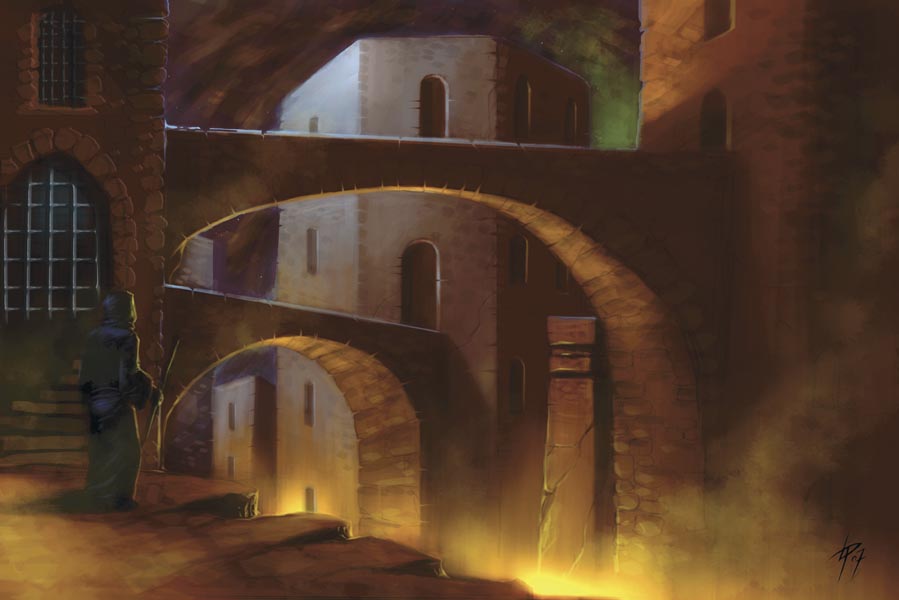24. Domain of the Duergar

24. Domain of the Duergar

|
|
|
|
|
|
|
|
|
|
|
|
Geography: This large
network of caverns is the home of the
largest concentration of
gray
dwarves, or duergar, in Deepearth.
Like the lairs of the svirfneblin,
these caves are all of natural origin,
although the duergar have
widened some passages and built
stairways. Nearly a hundred
caves make up the domain of the
duergar.
These are living caves that
contain plentiful supplies of fresh,
flowing water. Several of
the caves are almost completely filled
with water, although even
these have small air spaces near the
top with ledged walkways
so that the gray dwarves can move
through them. These caves
have been dammed to control outflow
so that the dwarves maintain
a large water supply even during
periods of drought.
Like the caves of the deep
gnomes, the duergar caves contain
large central open areas
with extensive networks of dungeons
and tunnels excavated for
living quarters along the sides. The
duergar also maintain a
large central cavern where they have
established a council chamber.
The tunnel leading east serves
as the outflow for most of the
water flowing through the
area. The stream in the tunnel is about
30 feet wide and is navigable
by small boats. A dry walkway runs
through the tunnel beside
the stream, allowing unimpeded travel
by foot as well.
Denizens: The duergar
are the main inhabitants of the area,
and number about 8,000.
Their caves are beehives of activity as
the diminutive demi-humans
go about their business. Like the
svirfneblin, the gray dwarves
maintain large herds of rothe.
In several small caves attached
to this network, the gray
dwarves allow small communities
of derro to live. Although the
derro are treated as second-class
citizens, they tolerate this
arrangement in order to
gain the protection offered by the huge
duergar population.
Hundreds of slaves are imprisoned
in small, poorly-ventilated
caverns among the dwellings
of the duergar. These slaves
include humans, goblins,
svirfneblin, and drow. Although they
are demoralized and listless,
there is a 25% chance that a given
group of them might be persuaded
to join in an escape attempt.
Many giant bats live in
niches among the ceilings of the
duergar caverns. The duergar
have done everything in their
power to eliminate these
pests, but they remain. The batsí favorite
prey is the rothe, but they
do not hesitate to seize a duergar,
derro, or slave if the opportunity
arises.
Resources: The water
supply is steady here, but even if it
were not, the reservoir
caverns contain enough water to last the
gray dwarves for several
years. The cavernsí proximity to the
Grand
Canyon insures an adequate air supply, and the duergar
have cut many air ducts
through the rocks to aid in air circulation.
At the southwestern end
of their domain, the duergar have
established an ambitious
mining operation. Like the svirfneblin
mines, these mines consist
of a three-dimensional network of
shafts and tunnels that
extends for many miles. The duergar
mine iron, copper, and gold.
Their mines are worked almost
exclusively by slaves.
Unique Features: The
duergar have developed the state of
metal-working to a fine
art; their tools, weapons, and
armor are all
of the highest quality.
They do not use gold for such mundane
purposes, however; instead
they have developed a cadre of
highly skilled gold sculptors.
The sculptors use stone to create
models of many statues and
these stone models are used to
make molds. Finally, the
molds are filled with pure, molten gold to
create exquisite and extremely
valuable works of art worth.
An average duergar residence
contains 1d6 x 100 gp worth of
small statuary. Larger residences
may have up to six times this
value. In public areas such
as the council chambers or inns, the
value of gold sculptures
is 2d6 x 1,000 gp. The largest chamber
holds life-size solid gold
statues of many prominent figures from
the raceís past. Each of
these contains about 20,000 gp worth of
gold. These values are for
the gold content of the statues only; if
the piece is returned to
the surface intact, its worth is ld4 + 1
times as much as its gold
content. Like the deep gnomes, the
duergar trade their products
with neighboring cultures.
The duergar have also developed
breweries that use a red fungus
rather than grain as a raw
material. The result is a pungent
and potent ale that is a
common drink among the gray dwarves.
Hence, each cavern has at
least one or two side caves hollowed
out as inns, and these are
well-attended at all times.